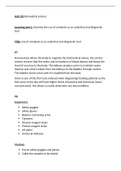Essay
BTEC Applied Science: Unit 20 Learning aim C
- Module
- Unit 20 - Biomedical Science
- Institution
- PEARSON (PEARSON)
Biomedical science, learning aim C, Distinction grade level, complete with graphs, tables and calculations included. SIDE NOTE: These assignments should only be used as a guide! These assignments are uploaded for you to see what a distinction level assignment looks like, not to be copied. Please se...
[Show more]





